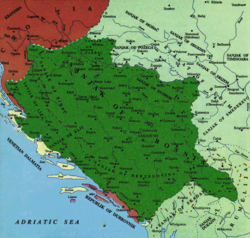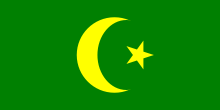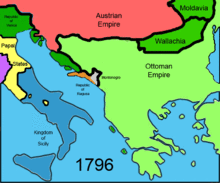- History of Bosnia and Herzegovina
-
History of
Bosnia and Herzegovina
This article is part of a seriesEarly History Prehistory and Roman era Slavic peoples Monarchy Bosnian Kingdom Ottoman era Austro-Hungarian condominium of Bosnia and Herzegovina Yugoslavia Kingdom of Yugoslavia World War II Socialist Federal Republic of Yugoslavia
(Socialist Republic of
Bosnia and Herzegovina)Contemporary War in Bosnia and Herzegovina Bosnia and Herzegovina
Bosnia and Herzegovina Portal
This is a history of Bosnia and Herzegovina.
Pre-Slavic Period (until 958)
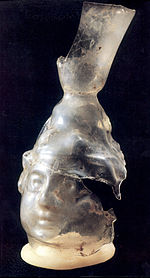 Roman glass found in Bosanski Novi from 2nd century
Roman glass found in Bosanski Novi from 2nd century Main article: History of Bosnia and Herzegovina (until 958)
Main article: History of Bosnia and Herzegovina (until 958)Bosnia has been inhabited at least since Neolithic times. In the late Bronze Age, the Neolithic population was replaced by more warlike Indo-European tribes known as the Illyrians. Celtic migrations in the 4th and 3rd century BCE displaced many Illyrian tribes from their former lands, but some Celtic and Illyrian tribes mixed.[1] Concrete historical evidence for this period is scarce, but overall it appears that the region was populated by a number of different peoples speaking distinct languages.[1] Conflict between the Illyrians and Romans started in 229 BCE, but Rome wouldn't complete its annexation of the region until 9 CE. In the Roman period, Latin-speaking settlers from all over the Roman empire settled among the Illyrians and Roman soldiers were encouraged to retire in the region.
Christianity had already arrived in the region by the end of the 1st century, and numerous artifacts and objects from the time testify to this. Following events from the years 337 and 395 when the Empire split, Dalmatia and Pannonia were included in the Western Roman Empire. The region was conquered by the Ostrogoths in 455, and further exchanged hands between the Alans and Huns in the years to follow. By the 6th century, Emperor Justinian had re-conquered the area for the Byzantine Empire. The Slavs, a migratory people from southeastern Europe, were angered by the Eurasian Avars in the 6th century, and together they invaded the Eastern Roman Empire in the 6th and 7th centuries, settling in what is now Bosnia and Herzegovina and the surrounding lands.[1] More South Slavs came in a second wave, and according to some scholars were invited by Emperor Heraclius to drive the Avars from Dalmatia.[1]
Medieval Bosnia (958–1463)
Modern knowledge of Bosnia in the western Balkans during the Dark Ages is patchy. Upon the looter invasions by the Avar and Slav horsemen from 6th-9th century, bringing Slavic languages (which prompted some to confuse that with the native Illyrian population turning Slav as well), both probably gave way to feudalism only with the might by the Frankish penetrating into the region in the late 9th century (Bosnia probably originated as one such pre-feudal entity). It was also around this time that the Bosnians were Christianized. Bosnia, due to its geographic position and terrain, was probably one of the last areas to go through this process, which presumably originated from the urban centers along the Dalmatian coast.[1] The region of Bosnia had been part of the kingdoms of Serbia and Croatia, whose borders were often fluctuant. However, by the high middle ages Croatia had been acquired by the Hungarian Kingdom, and the Serbian state to the southeast was in a period of stagnation. Control over Bosnia subsequently was contested between the Kingdom of Hungary and the Byzantine empire. Hungary appointed Ban Borić as the first ruler and Viceroy of Bosnia. Under the pressure of the Byzantine, a subsequent King of Hungary appointed one Kulin as a Ban to rule the province under the eastern vassalage. However, this vassalage was largely no XIV c.jpg|thumb|Bosnian Kingdom]]
The second Bosnian ruler, Ban Kulin, allegedly presided over nearly three decades of peace and stability during which he strengthened the country's economy through treaties with Dubrovnik and Venice. His rule also marked the start of a controversy with the Bosnian Church, an indigenous Christian sect considered heretical by both the Roman Catholic and Eastern Orthodox churches. In response to Hungarian attempts to use church politics regarding the issue as a way to reclaim sovereignty over Bosnia, Kulin held a council of local church leaders to renounce the heresy in 1203. Despite this, Hungarian ambitions remained unchanged long after Kulin's death in 1204, waning only after an unsuccessful invasion in 1254.
Kingdom of Bosnia
Main article: Kingdom of BosniaBosnian history from then until the early 14th century was marked by the power struggle between the Šubić and Kotromanić families. This conflict came to an end in 1322, when Stjepan II Kotromanić became ban. By the time of his death in 1353, he had succeeded in annexing territories to the north and west, as well as Zahumlje and parts of Dalmatia. He was succeeded by his nephew Tvrtko who, following a prolonged struggle with nobility and inter-family strife, gained full control of the country in 1367. Under Tvrtko, Bosnia grew in both size and power, finally becoming an independent kingdom in 1377. Following his death in 1391 however, Bosnia fell into a long period of decline. The Ottoman Empire had already started its conquest of Europe and posed a major threat to the Balkans throughout the first half of the 15th century. Finally, after decades of political and social instability, Bosnia officially fell in 1463, while resistance was active and fierce for a few more centuries. Southern regions of Bosnia, nowadays known as "Herzegovina" would follow in 1483, with a Hungarian-backed reinstated "Bosnian Kingdom" being the last to succumb in 1527.
Ottoman Era (1463–1878)
Main article: History of Bosnia and Herzegovina (1463–1878)The Ottoman conquest of Bosnia marked a new era in the country's history and introduced tremendous changes in the political and cultural landscape of the region. Although the kingdom had been crushed and its high nobility executed, the Ottomans nonetheless allowed for the preservation of Bosnia's identity by incorporating it as an integral province of the Ottoman Empire with its historical name and territorial integrity - a unique case among subjugated states in the Balkans.[2] Within this sandžak (and eventual vilayet) of Bosnia, the Ottomans introduced a number of key changes in the territory's socio-political administration; including a new landholding system, a reorganization of administrative units, and a complex system of social differentiation by class and religious affiliation.[1]
The four centuries of Ottoman rule also had a drastic impact on Bosnia's population make-up, which changed several times as a result of the empire's conquests, frequent wars with European powers, migrations, and epidemics.[1] A native Slavic-speaking Muslim community emerged and eventually became the second largest ethno-religious group (mainly as a result of a gradually rising number of conversions to Islam),[3] while a significant number of Sephardi Jews arrived following their expulsion from Spain in the late 15th century. The Bosnian Christian communities also experienced major changes. The Bosnian Franciscans (and the Catholic population as a whole) were protected by official imperial decree, although on the ground these guarantees were often disregarded and their numbers dwindled.[1] The Orthodox community in Bosnia, initially confined to Herzegovina and Podrinje, spread throughout the country during this period and went on to experience relative prosperity until the 19th century.[1] Meanwhile, the schismatic Bosnian Church disappeared altogether.
As the Ottoman Empire thrived and expanded into Central Europe, Bosnia was relieved of the pressures of being a frontier province and experienced a prolonged period of general welfare and prosperity.[3] A number of cities, such as Sarajevo and Mostar, were established and grew into major regional centers of trade and urban culture. Within these cities, various Sultans and governors financed the construction of many important works of Bosnian architecture (such as the Stari most and Gazi Husrev-beg's Mosque). Furthermore, numerous Bosnians played influential roles in the Ottoman Empire's cultural and political history during this time.[2] Bosnian soldiers formed a large component of the Ottoman ranks in the battles of Mohács and Krbava field, two decisive military victories, while numerous other Bosnians rose through the ranks of the Ottoman military bureaucracy to occupy the highest positions of power in the Empire, including admirals, generals, and grand viziers.[3] Many Bosnians also made a lasting impression on Ottoman culture, emerging as mystics, scholars, and celebrated poets in the Turkish, Arabic, and Persian languages.[3]
By the late 17th century, however, the Ottoman Empire's military misfortunes caught up with the country, and the conclusion of the Great Turkish War with the Treaty of Karlowitz in 1699 once again made Bosnia the empire's westernmost province. The following hundred years were marked by further military failures, numerous revolts within Bosnia, and several outbursts of plague.[1] The Porte's efforts at modernizing the Ottoman state were met with great hostility in Bosnia, where local aristocrats stood to lose much through the proposed reforms.[1] This, combined with frustrations over political concessions to nascent Christian states in the east, culminated in a famous (albeit ultimately unsuccessful) revolt by Husein Gradaščević in 1831.[3] Related rebellions would be extinguished by 1850, but the situation continued to deteriorate. Later, agrarian unrest eventually sparked the Herzegovinian rebellion, a widespread peasant uprising, in 1875. The conflict rapidly spread and came to involve several Balkan states and Great Powers, which eventually forced the Ottomans to cede administration of the country to Austria-Hungary through the Treaty of Berlin in 1878.[1]
Austro-Hungarian Era (1878–1918)
Main article: History of Bosnia and Herzegovina (1878–1918)Though an Austro-Hungarian occupying force quickly subjugated initial armed resistance upon take-over, tensions remained in certain parts of the country (particularly Herzegovina) and a mass emigration of predominantly Muslim dissidents occurred.[1] However, a state of relative stability was reached soon enough and Austro-Hungarian authorities were able to embark on a number of social and administrative reforms which intended to make Bosnia and Herzegovina into a "model colony".[2] With the aim of establishing the province as a stable political model that would help dissipate rising South Slav nationalism, Habsburg rule did much to codify laws, to introduce new political practices, and generally to provide for modernization.[2]
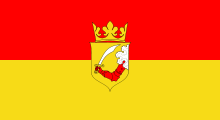

 Flag of Bosnia during Austro Hungarian administration (the country was formally under the sovereignty of the Ottoman Empire) (1878 - 1908)
Flag of Bosnia during Austro Hungarian administration (the country was formally under the sovereignty of the Ottoman Empire) (1878 - 1908)Although successful economically, Austro-Hungarian policy - which focused on advocating the ideal of a pluralist and multi-confessional Bosnian nation (largely favored by the Muslims) - failed to curb the rising tides of nationalism.[1] The concept of Croat and Serb nationhood had already spread to Bosnia and Herzegovina's Catholics and Orthodox communities from neighboring Croatia and Serbia in the mid 19th century, and was too well-entrenched to allow for the widespread acceptance of a parallel idea of Bosnian nationhood.[1] By the latter half of the 1910s, nationalism was an integral factor of Bosnian politics, with national political parties corresponding to the three groups dominating elections.
The idea of a unified South Slavic state (typically expected to be spear-headed by independent Serbia) became a popular political ideology in the region at this time, including in Bosnia and Herzegovina.[2] The Austro-Hungarian government's decision to formally annex Bosnia-Herzegovina in 1908 (the Bosnian Crisis) added to a sense of urgency among these nationalists.[2] The political tensions caused by all this culminated on 28 June 1914, when Serb nationalist youth Gavrilo Princip assassinated the heir to the Austro-Hungarian throne, Archduke Franz Ferdinand, in Sarajevo; an event that proved to be the spark that set off World War I. Although 10% of the Bosniak population died serving in the armies or being killed by the various warring states, Bosnia and Herzegovina itself managed to escape the conflict relatively unscathed.[2]
Kingdom of Yugoslavia (1918–1941)
Main article: History of Bosnia and Herzegovina (1918–1941)Following World War I, Bosnia was incorporated into the South Slav kingdom of Serbs, Croats and Slovenes (soon renamed Yugoslavia). Political life in Bosnia at this time was marked by two major trends: social and economic unrest over "Agrarian Reform 1918-1919" manifested through mass colonization and property confiscation;[4] also formation of several political parties that frequently changed coalitions and alliances with parties in other Yugoslav regions.[2] The dominant ideological conflict of the Yugoslav state, between Croatian regionalism and Serbian centralization, was approached differently by Bosnia's major ethnic groups and was dependent on the overall political atmosphere.[1] Although the initial split of the country into 33 oblasts erased the presence of traditional geographic entities from the map, the efforts of Bosnian politicians such as Mehmed Spaho ensured that the six oblasts carved up from Bosnia and Herzegovina corresponded to the six sanjaks from Ottoman times and, thus, matched the country's traditional boundary as a whole.[1]
The establishment of the Kingdom of Yugoslavia in 1929, however, brought the redrawing of administrative regions into banates that purposely avoided all historical and ethnic lines, removing any trace of a Bosnian entity.[1] Serbo-Croat tensions over the structuring of the Yugoslav state continued, with the concept of a separate Bosnian division receiving little or no consideration. The famous Cvetković-Maček agreement that created the Croatian banate in 1939 encouraged what was essentially a partition of Bosnia between Croatia and Serbia.[3] However, outside political circumstances forced Yugoslav politicians to shift their attention to the rising threat posed by Adolf Hitler's Nazi Germany. Following a period that saw attempts at appeasement, the signing of the Tripartite Treaty, and a coup d'état, Yugoslavia was finally invaded by Germany on 6 April 1941.[1]
World War II (1941–1945)
Main article: History of Bosnia and Herzegovina (1941–1945)A Monument commemorating the Battle of Sutjeska in eastern Bosnia and Herzegovina, modern-day Republika Srpska.
Once the kingdom of Yugoslavia was conquered by Nazi forces in World War II, all of Bosnia was ceded to the Independent State of Croatia. The Nazi rule over Bosnia led to widespread persecution. The Jewish population was nearly exterminated. Tens of thousands of Serbs died in Croat concentration camps. Many Serbs in the area took up arms and joined the Chetniks; a Serb nationalist and royalist movement that collaborated with the Nazis and committed numerous atrocities against chiefly Bosnian Muslim civilians in regions under their control.[3] Consequently, several Bosnian Muslim paramilitary units joined the Croatian Axis forces to counter their own persecution in the hands of the Serbs in Bosnia. On October 12, 1941 a group of 108 notable Muslim citizens of Sarajevo signed the Resolution of Sarajevo Muslims by which they condemned the persecution of Serbs organized by Ustaše, made distinction between Muslims who participated in such persecutions and whole Muslim population, presented informations about the persecutions of Muslims by Serbs and requested security for all citizens of the country, regardless of their identity.[5]
Starting in 1941, Yugoslav communists under the leadership of Josip Broz Tito organized their own multi-ethnic resistance group, the partisans, who fought against Axis, Ustase, and Chetnik forces.[1] On 25 November 1943 the Anti-Fascist Council of National Liberation of Yugoslavia with Tito at its helm held a founding conference in Jajce where Bosnia and Herzegovina was reestablished as a republic within the Yugoslavian federation in its Ottoman borders. Military success eventually prompted the Allies to support the Partisans, and the end of the war resulted in the establishment of the Federal People's Republic of Yugoslavia, with the constitution of 1946 officially making Bosnia and Herzegovina one of six constituent republics in the new state.[1]
Socialist Yugoslavia (1945–1992)
Main article: History of Bosnia and Herzegovina (1945–1992)Because of its central geographic position within the Yugoslavian federation, post-war Bosnia was strategically selected as a base for the development of the military defense industry. This contributed to a large concentration of arms and military personnel in Bosnia; a significant factor in the war that followed the break-up of Yugoslavia in the 1990s.[1] However, Bosnia's existence within Yugoslavia, for the large part, was peaceful and prosperous. Being one of the poorer republics in the early 1950s it quickly recovered economically, taking advantage of its extensive natural resources to stimulate industrial development. The Yugoslavian communist doctrine of "brotherhood and unity" particularly suited Bosnia's diverse and multi-ethnic society that, because of such an imposed system of tolerance, thrived culturally and socially.
Though considered a political backwater of the federation for much of the 50s and 60s, the 70s saw the ascension of a strong Bosnian political elite. While working within the communist system, politicians such as Džemal Bijedić, Branko Mikulić and Hamdija Pozderac reinforced and protected the sovereignty of Bosnia and Herzegovina [6] Their efforts proved key during the turbulent period following Tito's death in 1980, and are today considered some of the early steps towards Bosnian independence. However, the republic hardly escaped the increasingly nationalistic climate of the time unscathed. With the fall of communism and the start of the break-up of Yugoslavia, the old communist doctrine of tolerance began to lose its potency, creating an opportunity for nationalist elements in the society to spread their influence.
Bosnian War (1992-1995)
Main article: Bosnian War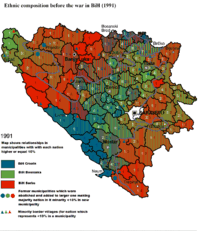 The distribution of the three main ethnic groups in 1991 prior to the Bosnian War.
The distribution of the three main ethnic groups in 1991 prior to the Bosnian War.
The first multi-party parliamentary elections held on 18 and 25 November 1990 [7] led to a national assembly dominated by three ethnically-based parties, which had formed a loose coalition to oust the communists from power. Croatia and Slovenia's subsequent declarations of independence and the warfare that ensued placed Bosnia and Herzegovina and its three constituent peoples in an awkward position. A significant split soon developed on the issue of whether to stay with the Yugoslav federation (overwhelmingly favored among Serbs) or seek independence (overwhelmingly favored among Bosniaks and Croats). A declaration of sovereignty on 15 October 1991 was followed by a referendum for independence from Yugoslavia on 29 February and 1 March 1992. The referendum was boycotted by the great majority of Bosnian Serbs, so with a voter turnout of 64%, 98% of which voted in favor of the proposal. Bosnia and Herzegovina became an independent state on 3 March 1992.[1]
While the first casualty of the war is debated, significant Serbian offensives began in March 1992 in Eastern and Northern Bosnia. Following a tense period of escalating tensions the opening shots in the incipient Bosnian conflict were fired when Serb paramilitary forces attacked Bosniak villages around Capljina on 7 March 1992 and around Bosanski Brod and Gorazde on 15 March. These minor attacks were followed by much more serious Serb artillery attacks on Neum on 19 March and on Bosanski Brod on 24 March. The killing of a Bosniak civilian woman on 5 April 1992 by a sniper, while she was demonstrating in Sarajevo against the raising of barricades by Bosnian Serbs, is widely regarded as marking the start of warfare between the three major communities..[8] Open warfare began in Sarajevo on April 6.[1] International recognition of Bosnia and Herzegovina meant that the Yugoslav People's Army (JNA) officially withdrew from the republic's territory, although their Bosnian Serb members merely joined the Army of Republika Srpska. Armed and equipped from JNA stockpiles in Bosnia, supported by volunteers, Republika Srpska's offensives in 1992 managed to place much of the country under its control.[1] By 1993, when an armed conflict erupted between the Sarajevo government and the Croat statelet of Herzeg-Bosnia, about 70% of the country was controlled by the Serbs.[2]
In March 1994, the signing of the Washington accords between the Bosniak and ethnic-Croatian leaders led to the creation of a joint Bosniak-Croat Federation of Bosnia and Herzegovina. This, along with international outrage at Serb war crimes and atrocities (most notably the Srebrenica massacre of as many as 8,000 Bosniak males in July 1995[9]) helped turn the tide of war. The signing of the Dayton Agreement in Paris by the presidents of Bosnia and Herzegovina (Alija Izetbegović), Croatia (Franjo Tuđman), and Yugoslavia (Slobodan Milošević) brought a halt to the fighting, roughly establishing the basic structure of the present-day state. The three years of war and bloodshed had left between 200,000 and 250,000 people killed and more than 2 million displaced.[10]
Independent Bosnia and Herzegovina
 Coat of arms of Bosnia and Herzegovina
Coat of arms of Bosnia and Herzegovina See also: Politics of Bosnia and Herzegovina
See also: Politics of Bosnia and HerzegovinaSince its 1992 independence and the 1995 Constitutional framework of the Dayton Agreement, Bosnia and Herzegovina has followed a path of state-building, while remaining under final international supervision through the figure of the High Representative for Bosnia and Herzegovina. Bosnia and Herzegovina is a confederation of two Entities - the Federation of Bosnia and Herzegovina and the Republika Srpska, as well as the district of Brčko. Each of the Entities has its own constitution and extensive legislative powers.
Bosnia and Herzegovina is a potential candidate country for accession into the EU; an EU-BiH Stabilization and Association Agreement has been signed in 2008. Its accession to NATO is in the phase of negotiation, and a Membership Action Plan has been signed in April 2010.
See also
- Bosnian Genocide
- Breakup of Yugoslavia
- Demographic history of Bosnia and Herzegovina
- Herceg Bosna
- History of Yugoslavia
- History of the Balkans
- History of Europe
- League of Communists of Yugoslavia
- President of Bosnia and Herzegovina
- List of Prime Ministers of Bosnia and Herzegovina
- List of heads of state of Yugoslavia
- List of Prime Ministers of Yugoslavia
- Politics of Bosnia and Herzegovina
- Republic Srpska
References
- ^ a b c d e f g h i j k l m n o p q r s t u v w Malcolm, Noel (1994). Bosnia A Short History. New York University Press. ISBN 0-8147-5520-8.
- ^ a b c d e f g h i Riedlmayer, Andras (1993). A Brief History of Bosnia-Herzegovina. The Bosnian Manuscript Ingathering Project.
- ^ a b c d e f Imamović, Mustafa (1996). Historija Bošnjaka. Sarajevo: BZK Preporod. ISBN 9958-815-00-1
- ^ An International Symposium "South-Eastern Europe 1918-1995" Serbian Land Reform and Colonization in 1918
- ^ Hadžijahić, Muhamed (1973) "Muslimanske rezolucije iz 1941 godine [Muslim resolutions of 1941"] (in Serbocroatian) Istorija Naroda Bosne i Hercegovine Sarajevo: Institut za istoriju radničkog pokreta p. 277 http://www.scribd.com/doc/47323922/Muhamed-Hadzijahic-Muslimanske-rezolucije-1941
- ^ Stojic, Mile (2005). Branko Mikulic - socialist emperor manqué. BH Dani
- ^ http://phron.org/Reference/Books/Balkans%20-%20post%20communist%20history.pdf
- ^ http://phron.org/Reference/Books/Balkans%20-%20post%20communist%20history.pdf
- ^ Federal Commission for Missing Persons; "Preliminary List of Missing and Killed in Srebrenica"; 2005 [1]PDF (522 KB).
- ^ November. 21, 2005. Bosnian war "claimed 100,000 lives". Deutsche Presse-Agentur.
Further reading
- Marko Attila Hoare, The History of Bosnia: From the Middle Ages to the Present Day, London: Saqi, 2007
- Roger Cohen, Hearts Grown Brutal: Sagas of Sarajevo, New York: Random House, 1998
- Lenard J. Cohen, Broken Bonds: The Disintegration of Yugoslavia, Boulder, Colorado: Westview Press, 1993
- Roy Gutman, A Witness to Genocide: The 1993 Pulitzer prize-winning dispatches on the "ethnic cleansing" of Bosnia, New York: Macmillan, 1993
- Noel Malcolm, Bosnia: A Short History, 1994
- Murray, Elinor et al., The Struggle for Peace in Bosnia: Considering U.S. Options, Providence, RI: Center for Foreign Policy Development of Brown University, 1992, ED 371 965
- Matthew Parish, A Free City in the Balkans: Reconstructing a Divided Society in Bosnia, London: I.B.Tauris, 2009
- Paolo Rumiz, Maschere per un massacro, Editori Riuniti, Roma, 2000
- Joe Sacco, War's End Profiles from Bosnia 1995-96, Drawn & Quarterly, 2005
- Michael Sells, The Bridge Betrayed: Religion and Genocide in Bosnia, University of California Press, 1996
- Charles Shafer, Not My War, Williams and Wiliams Press, 2004.
- Ed Vulliamy, Seasons in Hell: Understanding Bosnia's War, New York: St. Martin's Press, 1994
External links
General history
- Serbian land reform and colonization of Bosnia and Herzegovina in 1918, by Dženana E. Semiz, University of Sarajevo (strongly recommended)
- Oriental Institute Sarajevo
- Bosniak Institute Sarajevo
- Bosnian Institute
- Bosnian language
- Bosnia and Herzegovina: Everything you need to know
- Genealogy of Rulers and History of Medieval Bosnia (Excellent web source)
- Origin of the Medieval Bosnian Royal Dynasty Kotromani (Excellent web source)
- Regnal Chronologies (Excellent resource)
- Historical and Geographical Outline (Note huge discrepancy between relatively objective views in authoring texts hosted by tha site and general editor contributions in writings on issue of medieval and history of Bosnia and Herzegovina in general)
- Medieval Bosnia: a reassessment - Bosnian Borders (Note huge discrepancy between relatively objectiv views in authoring texts hosted by tha site and general editor contributions in writings on issue of medieval and history of Bosnia and Herzegovina in general)
- The Hval Manuscript
- Selected Bibliography of English-language Print Resources for Bosnia and Herzegovina at Yale University Library (Excellent web source)
- General sources for the study of Bosnian Civilization
- Brief history of Bosnia and Herzegovina
- Religion and culture in medieval Bosnia, from "The Late Medieval Balkans" by John V.A Fine, Jr.
- A Brief History of Bosnia-Herzegovina by Andras Riedlmayer, Harvard University
- History of Bosnia and Herzegovina
- WWW-VL: History: Bosnia & Herzegovina
- Bosnian history
- Open Book: Preserving Cultural Heritage of Bosnia and Herzegovina
- ODJEK - review for Art, Science and Social issues
- Spirit of Bosnia
- Timeline: Bosnia-Hercegovina at BBC News
Bosnian War and post-war history
- John K. Cox: Teaching about Conflict and Crisis in the Former Yugoslavia: The Case of Bosnia-Hercegovina
- Sobaka Bosnia articles
- Herceg Bosna: Myths about Croatian long-term strategy of the Bosnia partition
- TIME Daily short timeline of Bosnian conflict
- OHR ethnic maps of Bosnia and Herzegovina
- Washington Post: An overview of war
- Bosnia HomePage at Caltech
- Bosnia: a single country or an apple of discord?, Bosnian Institute, 12 May 2006
- hWeb - Convoy to Sarajevo, a personal account of relief work during the Bosnia War
- Visegrad Genocide Memories
 Bosnia and Herzegovina topics
Bosnia and Herzegovina topicsHistory Illyricum • Bosnian Kingdom • Ottoman Bosnia and Herzegovina • Kingdom of Yugoslavia • World War II • Socialist Federal Republic of Yugoslavia • Socialist Republic of Bosnia and Herzegovina • Republic of Bosnia and Herzegovina • Bosnian War • Bosnia and HerzegovinaGeography Politics Constitution • Parliament • Prime Minister • President • Elections • Political parties • Foreign relations • Government • Agencies • Law enforcement • LGBT rightsEconomy Military Symbols Demographics Administrative divisions • Cities • Human rights • Postal codes • Languages • Religion • Bosnians • List of BosniansCulture Academy • Architecture • Art • Cinema • Music • Cuisine • Bosnian language • Literature (Poets) • Philosophy • Folklore • Radio • TelevisionWikiProject • Portal History of Europe Prehistoric Europe Classical Antiquity Classical Greece · Roman Republic · Hellenistic period · Roman Empire · Late Antiquity · Early Christianity · Crisis of the 3rd century · Fall of the Roman EmpireMiddle Ages Early Middle Ages · Migration Period · Byzantine Empire · Christianization · Kievan Rus · High Middle Ages · Holy Roman Empire · Crusades · Feudalism · Late Middle Ages · Hundred Years' War · RenaissanceEarly Modern Europe Reformation · Age of Discovery · Baroque · Thirty Years' War · Absolutism · Ottoman Empire · Portuguese Empire · Spanish Empire · Early modern France · Polish–Lithuanian Commonwealth · Swedish Empire · Dutch Republic · British Empire · Habsburg Empire · Russian EmpireModern history See also History of Europe by country Sovereign
states- Albania
- Andorra
- Armenia
- Austria
- Azerbaijan
- Belarus
- Belgium
- Bosnia and Herzegovina
- Bulgaria
- Croatia
- Cyprus
- Czech Republic
- Denmark
- Estonia
- Finland
- France
- Georgia
- Germany
- Greece
- Hungary
- Iceland
- Ireland
- Italy
- Kazakhstan
- Latvia
- Liechtenstein
- Lithuania
- Luxembourg
- Macedonia
- Malta
- Moldova
- Monaco
- Montenegro
- Netherlands
- Norway
- Poland
- Portugal
- Romania
- Russia
- San Marino
- Serbia
- Slovakia
- Slovenia
- Spain
- Sweden
- Switzerland
- Turkey
- Ukraine
- United Kingdom
- (England
- Northern Ireland
- Scotland
- Wales)
- Vatican City
States with limited
recognition- Abkhazia
- Kosovo
- Nagorno-Karabakh
- Northern Cyprus
- South Ossetia
- Transnistria
Dependencies
and other territories- Åland
- Faroe Islands
- Gibraltar
- Guernsey
- Jan Mayen
- Jersey
- Isle of Man
- Svalbard
Other entities - European Union
- Sovereign Military Order of Malta
European Middle Ages Early Middle Ages Migration Period · Decline of the Western Roman Empire · Late Antiquity · Decline of Hellenistic religion · Christianization · Rise of Islam · First Bulgarian Empire · Frankish Empire · Bagratid Kingdom of Armenia · Kingdom of Croatia · Anglo-Saxon England · Viking Age · Carolingian Empire · Old Church Slavonic · Kievan Rus' · Growth of the Eastern Roman EmpireHigh Middle Ages Holy Roman Empire · Armenian Kingdom of Cilicia · Second Bulgarian Empire · Feudalism · Great Schism · Investiture controversy · Crusades · Scholasticism · Monasticism · Communalism · Manorialism · Medieval Warm PeriodLate Middle Ages Culture Architecture · Art · Church and State · Cuisine · Demography · Literature · Medicine · Music · Philosophy · Poetry · Science · Technology · WarfareSee also Republics and autonomous provinces of the Socialist Federal Republic of Yugoslavia Bosnia and Herzegovina · Croatia · Macedonia · Montenegro · Serbia (Vojvodina • Kosovo) · Slovenia
Categories:
Wikimedia Foundation. 2010.

